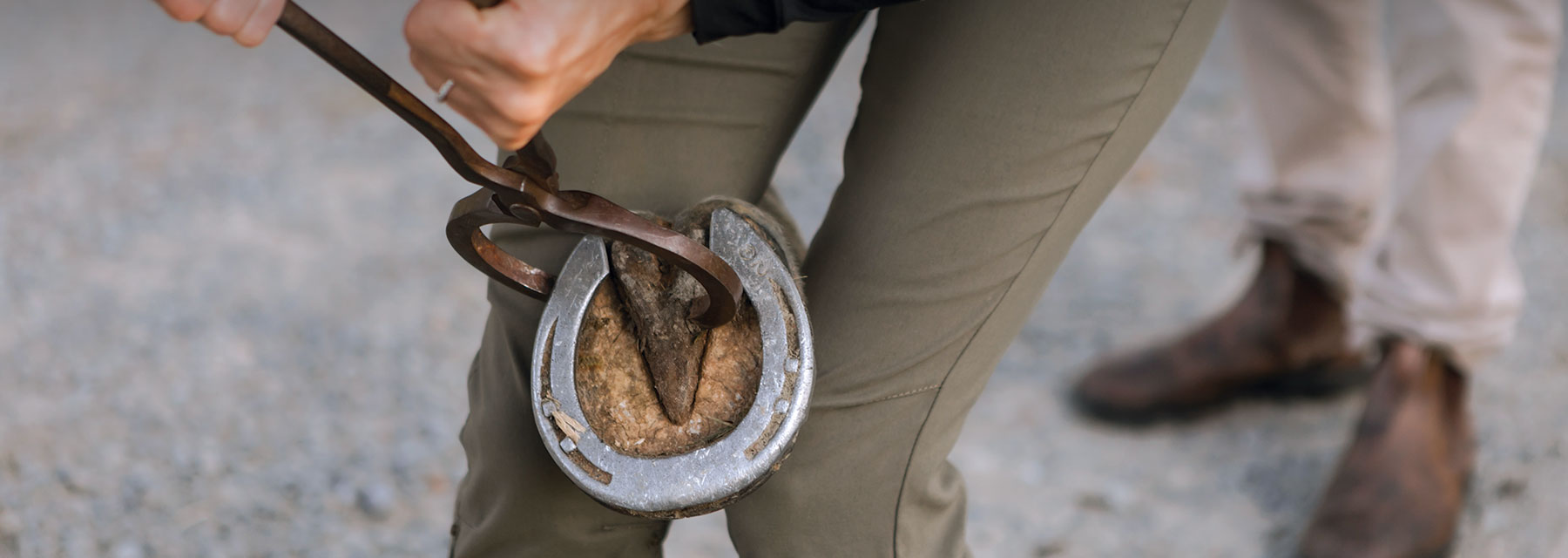World Leaders in Equine Podiatry Gather to Discuss The Latest Research, Techniques and Technology Surrounding The Equine Hoof and Beyond
It was a warm weekend in early July when the stunning landscape near Portland, Oregon, greeted many of the world’s foremost in equine podiatry. Farriers, veterinarians and footing experts gathered for “From the Ground Up,” a two-day seminar to discuss the all-important equine foot and share, at length, their invaluable experience, research and knowledge gathered from decades in the field. The event was hosted by Northwest Equine Performance, a widely-respected sports medicine practice founded by former U.S. Equestrian team veterinarian Dr. Mark Revenaugh, and the much-revered Equine High Performance Sports Group, a community for innovative education and research in sport horse care, focused on learning and improving the health and performance of athletes. The goal was to create a collegial environment where forward progress could be made concerning the equine hoof, which impacts soundness, performance and longevity for every equine athlete. Lectures ranged from barefoot locomotion to novel gait analysis technology and advancements in performance shoeing to a deep dive into the science behind various footing options delivered by Lars Roepstorff, DVM, PhD of Uppsala, Sweden, and western performance footing expert Randy Fenimore. Above all, each podiatry titan was there for the ultimate benefit of the horses they serve.
Select Seminar Topics & Speakers
Static and Dynamic Observation of the Foot
Tim Shannon, CJF, APF, AWCF, Moreno Valley, California, and Mark Silverman, MS, DVM, Sporthorse Veterinary Services, Rancho Santa Fe, California
Effect of Barefoot vs. Shod on Locomotion
Lars Roepstorff, DVM, Ph.D., professor in the Department of Anatomy, Physiology and Biochemistry at Swedish University of Agricultural Sciences, Uppsala, Sweden
Foot X-ray Technique and Interpretation — What Matters?
Mark Silverman, MS, DVM; Tim Ober, DVM, partner John R. Steele & Associates Inc., Vernon, New York; Charlie Buchanan, DVM, founder Signature Equine Hospital, Stephenville, Texas; and Steve Teichman, retired farrier based in Unionville, Pennsylvania
The Value of Magnetic Resonance Imaging for Difficult Foot Cases
Rachel Buchholz, DVM, Northwest Equine Performance, Mulino, Oregon
Can Shoes Allow Heel Expansion as in Barefoot
Bart Halsberghe, DVM, DECVSMR, Global Equine Veterinary Consulting, Belgium; and Didier Rondelez, farrier, Belgium
Lessons learned as USA Team Farrier for 25 Years
Steve Teichman, farrier
Quantitative Gait Analysis in Clinical Practice
Marc Koene, DVM, Luesche Equine Veterinary Clinic, Luesche, Germany
Where Are We With Interventional Therapies?
Mark Revenaugh, DVM, founder Northwest Equine Performance, Mulino, Oregon
Advanced Nutrition for Podiatry
Matt Durham, DVM, DACVSMR
Considerations for Western Performance Shoeing
Pete May, farrier, Springtown, Texas; and Kyle Kukla, farrier, Stephenville, Texas
Measurable Parameters for Footing and Why They Matter
Lars Roepstorff, DVM, Ph.D.
Shoe Selection for Specific Footing/Disciplines
Steve Teichman, farrier; Lars Roepstorff, DVM, Ph.D.; and Mark Silverman, MS, DVM
Strategies and Limitations for Nerve Blocks
Charlie Buchanan, DVM; Rick Mitchell, DVM, MRCVS, DACVSMR, senior partner at Fairfield Equine Associates, Newton, Connecticut; and B art Halsberghe, DVM, DACVSMR, DVM
A New Technique for Thin Walls; “Hoof Wrap”
Steve Teichman, farrier
Regional Foot Perfusion
David Dutton, DVM, DACVS, professor of large animal surgery at Texas Tech University, School of Veterinary Medicine, Amarillo
Farrier and Veterinarian Collaborations
Jim Meyers, DVM
“Every foot tells a story.”
— Mark Silverman, DVM, MS, Sporthorse Veterinary Services in Rancho Santa Fe, California
A taste of the novel content delivered at the "From the Ground Up" conference:
Static and Dynamic Observation of the Foot
Tim Shannon, CJF, APF, AWCF and Mark Silverman, MS, DVM
“Every foot tells a story,” Dr. Mark Silverman told the audience. “You can look at a foot and tell a lot about what’s happening with that horse by the way the feet are growing and wearing.” Regarding static and dynamic hoof balance, he asked the audience: “Why does it really matter if the hoof is in balance?” Beginning with static assessment, he outlined how several balance parameters can be considered regarding the foot, but at most only one or two will actually come into play for each horse. “The science is there in terms of using radiographs and other imaging combined with our eyes to figure things out,” Dr. Silverman explained. “The art is figuring out what balance parameter is going to work for that individual.” Those can include examining the hairline as well as alignment of the joints to the long axis of the leg, to name a few. “What are we looking at in terms of dynamic balance?” added Tim Shannon, a farrier. “We’re going to look at how the horse moves, trot it out, trot it back, walk it, move it in front of us and look at fetlock drop, which is very important,” he said. “I want to see what direction that limb is coming down or where the fetlock drops between the heels and which direction it’s going. That tells me a lot about the direction of force going into the foot.” The pair also addressed landing and loading. “We tend to separate the two,” Dr. Silverman pointed out. “We can’t always correct it but can we smooth it out during transition to lessen the impact of that trauma on the horse or downgrade the shock.” With a thorough static assessment supported by quality radiographs, veterinarians and farriers working together can paint a more complete picture of where they need to go regarding trimming, shoeing and tailoring their work to each horse’s individual needs. With that, Dr. Silverman left the audience with a thought learned from a farrier friend he keeps top of mind: “The trim and the shoe that you apply to this horse is the only way that those 1,400 pounds plus rider connects to the world.” With that, Dr. Silverman concluded, “When we look at things that way, as the communication between earth and horse, it shows us how important this is and how to get out of the horse’s way a little bit to better let the horse’s feet work as they need to.”
“The trim and the shoe that you apply to this horse is the only way that those 1,400 pounds plus rider connects to the world.”
— Dr. Mark Silverman, Borrowing the sentiment from a friend
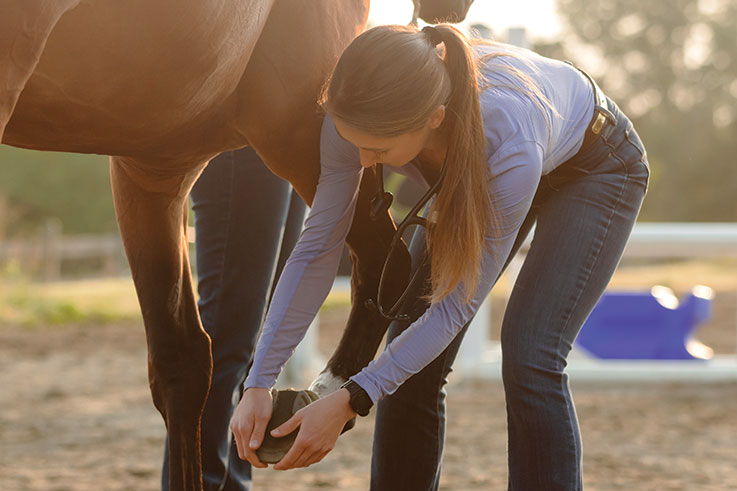
Several balance parameters can be considered regarding the foot, but at most only one or two will actually come into play for each horse.
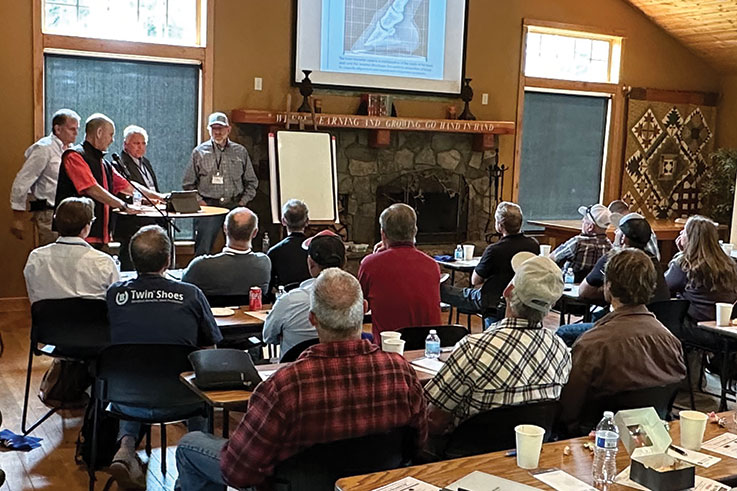
Farriers, veterinarians and footing experts gathered for “From the Ground Up,” a seminar to discuss the equine foot.
COURTESY PHOTO
Quantitative Gait Analysis in Clinical Practice
Marc Koene, DVM
One advantage of equine veterinary gatherings, like “From the Ground Up,” is the discussion of novel technology and its impact on diagnostics, care and patient outcomes. Dr. Marc Koene discussed a new option in the motion capture-gait analysis realm known as Sleip. “This technology is a great tool. It’s about objective gait analysis and fusing the worlds of artificial intelligence (AI) and equine biomechanics,” he said. “How do you measure gait (kinetics and kinematics)? Methods to measure kinetics (force) include force plates, pressure plates, force-measuring horseshoes and an instrumental treadmill. In addition to gait, kinematics (movement) can be measured using 3-D optical motion capture — an example of which can be seen in the leading Qualisys brand system, inertial measurement unit (IMU) sensors and video analysis using computer vision or AI.” The Qualisys system Dr. Koene mentioned can require approximately 30 cameras making it an exceptional diagnostic and preventive tool, albeit an expensive one. There are no batteries, an unlimited number of markers (placed on the withers, hips, poll and beyond), and the system allows practitioners to measure numerous horses in a short amount of time. While Dr. Koene is clearly impressed by it — he uses Qualisys motion capture in his practice — he gave an overview of the novel Sleip system as an alternative, which uses a markerless live video gait analysis system. The alternative, IMU systems, while still expensive, can cost considerably less than 3-D optical motion capture systems such as Qualisys, though they can also be slightly less accurate and limited in terms of the number of sensors (placed predominantly on the hip, head or poll specifically).
They are dependent on batteries and the systems don’t produce video. Where does this technology fit in comparison to existing systems? “With this technology you get a high-class video, and you can do this with your iPhone,” said Dr. Koene. “The clinic doesn’t need to buy any hardware.” Compared to 3-D optical motion capture systems, and perhaps most interesting, the practitioner can send an invitation to their client, and using the Sleip app the client then films their own horse, trotting the animal 30 meters forward and back two full times. The video is then immediately available for the practitioner to view and compare to the baseline for that patient. Data gathered from the Sleip system can indicate a range of diagnoses including weight bearing, impact, push off and mixed lamenesses. As much as he’s impressed with the technology, Dr. Koene is quick to add: “This is an aid … not a replacement for (practitioners).” While technology can augment the diagnostic process and provide data the human eye can’t observe, some practitioners may believe that over reliance on technology can hinder a proper use of the basics of good veterinary medicine. However, markerless mobile systems such as this are self-learning, provide early recognition of small changes and deliver the ability to monitor continuously. In Dr. Koene’s opinion, these are the way of the future.
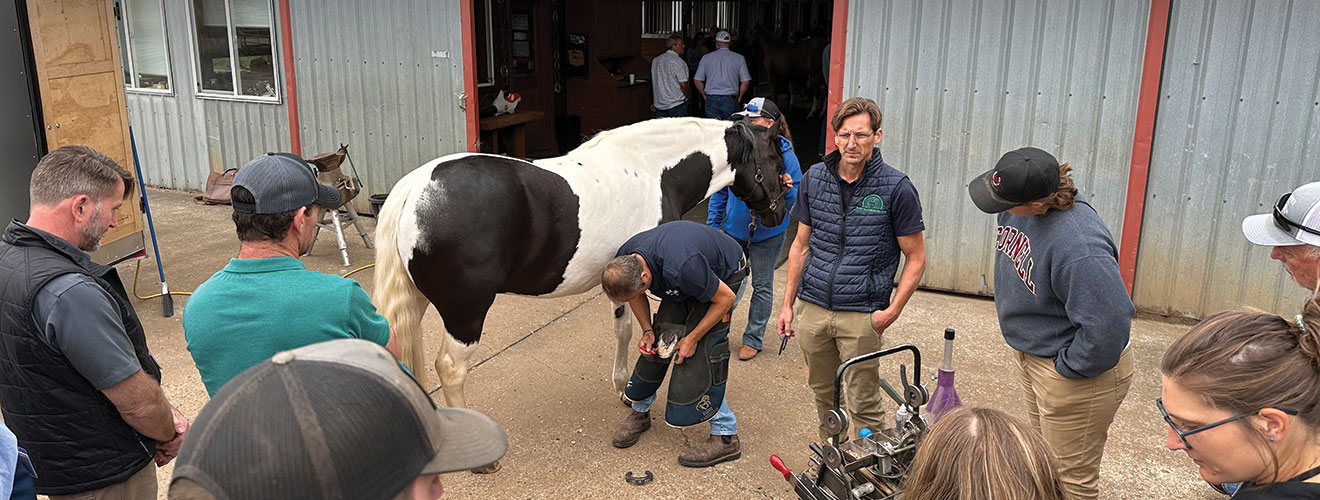
Lessons Learned from 25 Years as Team USA Farrier
Steve Teichman, Farrier
“There are two functions that I see for shoeing: It protects the foot, and it can alter performance. There can also be some combination of both,” said Teichman as he began his program based on 50 years experience as a professional shoer and over a quarter-century spent shoeing some of the finest competitive equestrian athletes in the world through five Olympic Games, five Pan-American Games and countless European competitions. “I’ve learned through life not to argue with illness, God or a good crisis, and shoeing sometimes puts you in that crisis mode,” he said with a laugh. “What really changed my outlook was taking on a team approach, I call it my ‘shoeing triangle.’ And that’s the rider- or groom-veterinarian- farrier relationship. You can only be a pro at one thing at a time. You really need to bring in other professionals when you need them, and when you bring them in, respect them.” Teichman, speaking upbeat but in a straight-to-thepoint style, says: “The key to shoeing is gravity and evolution. There are two things that you are never going to change about you and your horse: that’s gravity and the effects of millions of years of biomechanical and neurological evolution, plain and simple. So, we have to work within that framework. How we manage these forces is going to be the cause and the cure of a lot of these health issues.” He went on to discuss how, in actuality, horses should be shod to accommodate what they do for the majority of their day: grazing, standing and sleeping. He explained that when care teams — including farriers — get tunnel vision and shoe a horse to accommodate the 45 minutes of approximate performance time they may have every day or several times per week, foot problems can arise. Part of his success as a farrier is his ability to take a global perspective. He takes numerous factors into consideration with each horse, playing the long game for lasting soundness and success in competition. “I’m super conservative,” he explained. “That’s an important tip. Instead of getting in there and saying, ‘I’m going to cut off a lot of foot, and I’m going to really make a difference,’ sometimes being conservative for the first time around is really valuable.” In addition, he formulates a plan for each case that considers the goals for the horse, their travel, the changing climates they’ll experience and individual hoof care needs. “Having goals and plans in the offseason is important,” he said. “This will oftentimes be the place where I’ll institute the real adjustments, ensuring we’ll make it to the shows and be ready when we need to be. Instead of pulling shoes or shoeing them simply, that’s when I might say, ‘I’m going to stick this horse in heart bars until January, and I’m going to really remodel that hoof capsule and develop these heels.’ I’m not just going to bang some shoes on. This is about planning.”
After reviewing several cases, Teichman left the audience with his advice after decades as a farrier who has worked with high-level veterinarians around the world: “When it comes to communication between farriers and veterinarians, somebody said this the other day, that ‘We seldom speak the same language.’ As a group we’re getting better at this. I really push to reach them at their level, stand toe to toe and speak that same language. It’s important.” Indeed, there’s no question that a strong veterinarian-farrier relationship can improve outcomes for patients.
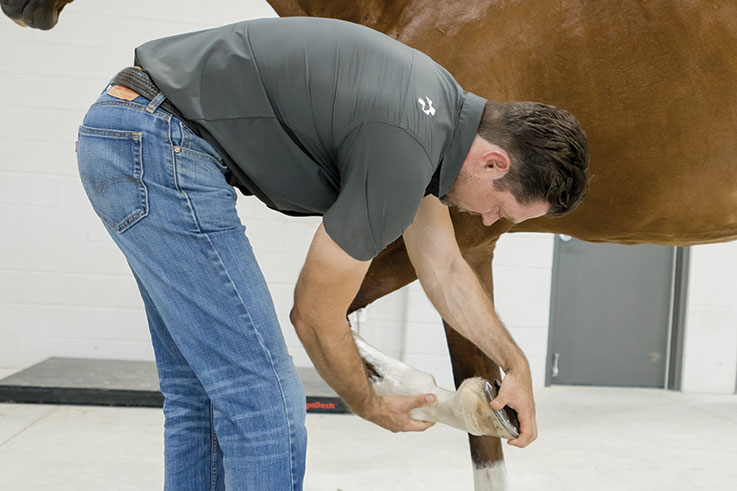
Dr. Beau Whitaker of Brazos Valley Equine in Salado, Texas, examines a patient’s hoof.
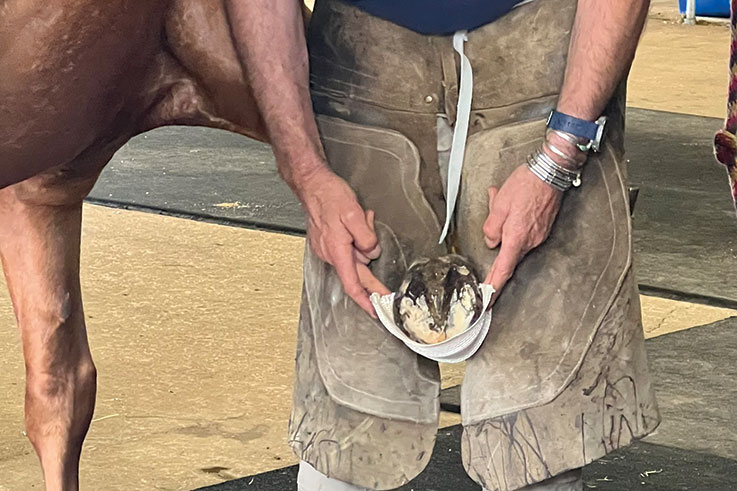
Riding Forward
So much has been learned in equine podiatry over the last several decades, laying the foundation for accelerated progress, continuous education, fruitful collaboration and immense benefits to the horse. With both private veterinarians and organizations like the American Association of Equine Practitioners (a Kentucky-based organization made up of nearly 9,300 veterinarians and veterinary students in 61 countries) committed to podiatry-focused programs, the equine foot will only grow in understanding and rightly so. Without healthy feet, there is no foundation of soundness for the horse and certainly no performance career. Luckily, there are dedicated and wildly-capable veterinarians and farriers taking point on education in the realm of equine podiatry, leaving little doubt that the veterinarians of tomorrow will have a firm grasp of anatomy, biomechanics and the all-important basics of farriery. In the end, it’s the horse that benefits.
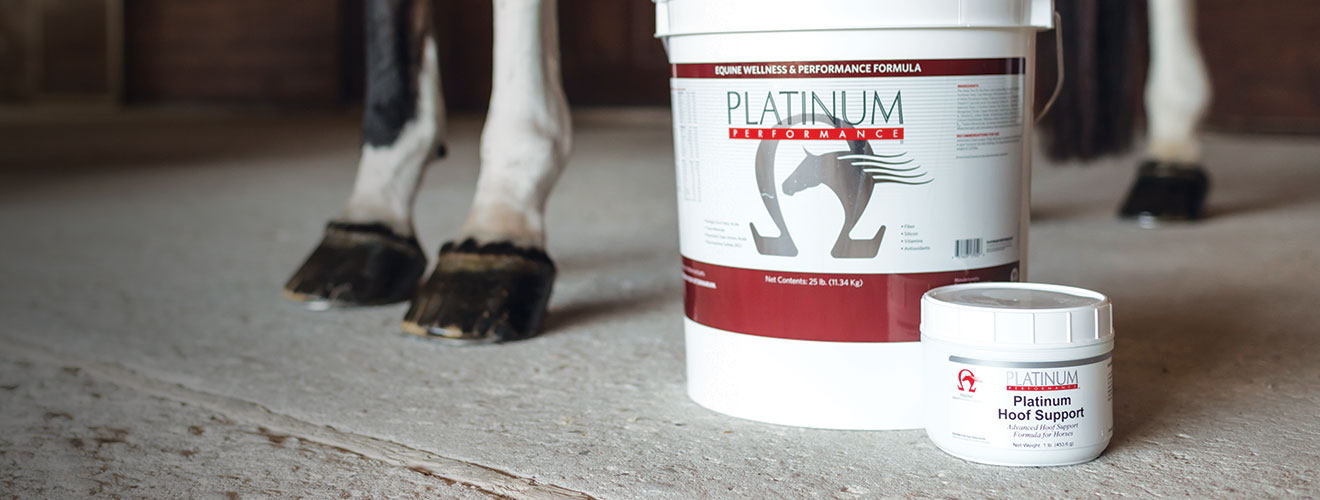
Podiatry: A Global View & Its Place in Curriculum
Equine Foot Advocates Making Progress and Veterinary Students Gaining Practical, Hands-On Experience
While immense progress is made from gatherings like “From the Ground Up,” there are long-standing advocates for equine podiatry who are making parallel progress throughout the equine world. From practitioners and farriers championing advancements in everyday equine podiatry, to the rise of podiatry programs within veterinary curriculum, a focus on the foot is blossoming around the world.
Dr. Stephen O’Grady — winner of the American Association of Equine Practitioners Distinguished Educator Award in December of 2020 and known to many as a living legend in veterinary farriery — has worked for most of his 50-year career as a pillar of knowledge for farriers and equine veterinarians. “I can’t stress the importance of the veterinarian-farrier relationship enough,” he emphasizes. “If we think about the horse’s foot, it’s the only part of veterinary medicine where you need two participants. The veterinarian oversees the whole horse, which obviously includes the horse’s foot. Any work that’s done on the horse’s foot, in most cases — maintenance, routine trimming, shoeing, specialty lameness work, hoof distortions — is performed by the farrier. To do that work, you need radiographs taken by the veterinarian, and you need a good handle on anatomy, which is where the veterinarian comes in again.” Dr. O’Grady says this partnership ultimately can lay the groundwork for more successful outcomes. “Bringing the two parties together comes down to one word: communication,” he says. “There are a lot of groups that are doing some strong work in this area,” he says. Along with the “From the Ground Up” seminar, the Nordic Hoof Summit, the largest annual hoof event in Northern Europe, was held in Flyinge, Sweden, on Sept. 22-24, featuring Dr. O’Grady and many of his colleagues as speakers. From France to Canada and throughout the U.S., numerous veterinary and farrier organizations and private practices are focused on furthering a stronger understanding of “the basics” and fostering a crucial relationship between veterinarians and farriers.
Another challenge is the shortage of equine veterinarians with deep, practical, hands-on experience with the equine foot. “It’s a deficiency we’ve historically felt in terms of veterinary school,” Dr. O’Grady says. Progress is being made, however, with several veterinarians committed to building academic programs that turn out students well-versed in the equine foot and ready to contribute on day one. “Pat Riley at the University of Pennsylvania brings equine veterinary medicine and farriery together nicely with hands-on education for students,” Dr. O’Grady offers. “Virginia Tech has a resident farrier who’s a good friend of mine and does an incredible job training the students there. And what Drs. Luke Bass and Raul Bras and their colleagues at Colorado State University (CSU) are doing is something unique,” he adds referring to the newly-established program designed to bring real-world podiatry and farriery experience to students via online and in-person training. “It’s fantastic,” says Dr. O’Grady of the work his friends and colleagues are doing to provide deep knowledge and skill to the upcoming generation of equine veterinarians.
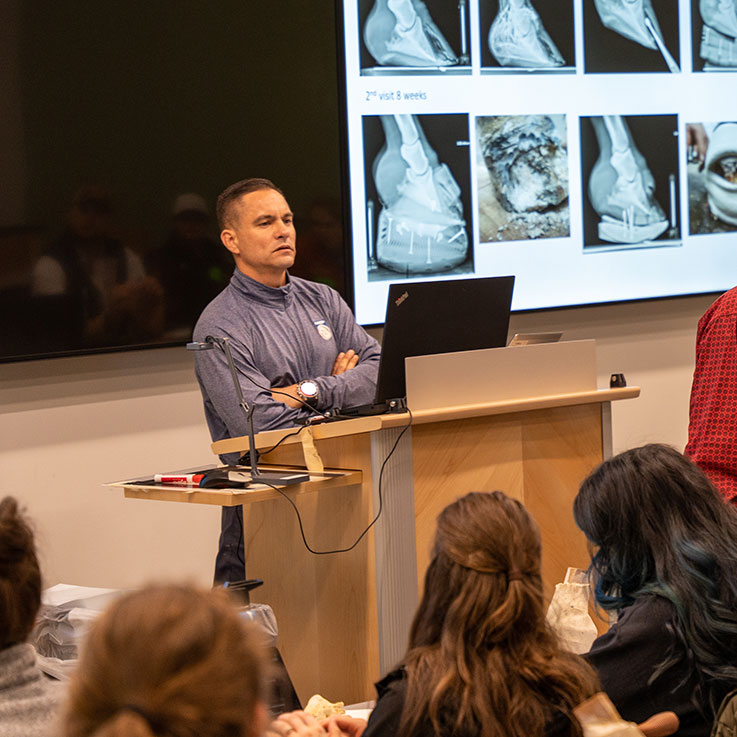
Dr. Stephen O’Grady — known to many as a living legend in veterinary farriery — has worked for most of his 50-year career as a pillar of knowledge for farriers and equine veterinarians.
COURTESY PHOTO
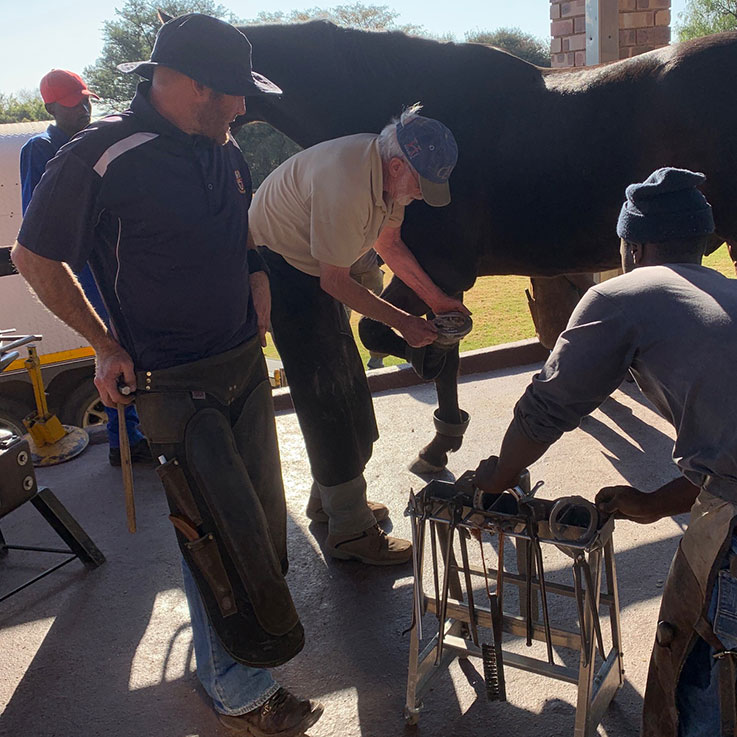
Dr. Raul Bras in a lecture at Colorado State University as a part of their new podiatry program.
COURTESY PHOTO
“We’ve taken great strides in bridging the gap between veterinarians and farriers; the two groups have really begun to come together and, in the end, it’s the horse that benefits.”
— Dr. Luke Bass, Colorado State University
A Snapshot of the Next Generation
Within the halls of CSU’s College of Veterinary Medicine and Biomedical Sciences several veterinarians tackled challenges surrounding the practice of podiatry inside equine veterinary medicine. “I grew up like most of us did, with a veterinarian and a farrier, and I didn’t realize that there’s teamwork that was necessary there,” says Dr. Bass, one of the founding veterinarians behind the university’s focused four-year podiatry program offered alongside the normal veterinary school curriculum, with the goal of training equine veterinarians with real-world experience in podiatry and, specifically, a strong understanding of farriery mechanics. “We’ve taken great strides in bridging the gap between veterinarians and farriers; the two groups have really begun to come together and, in the end, it’s the horse that benefits,” says Dr. Bass. It’s not only the melding of the two but the hands-on, learn-by-doing approach of the program that offers students a fresh approach to the subject. “When I was in school, we got very little exposure from both an educational and clinical standpoint,” Dr. Bass recalls. “I remember being out in California as an intern, driving to appointments and looking up Dr. O’Grady’s articles to figure out what I was supposed to do with white line disease. Now, we can do a much better job, and we have.”
It was that knowledge gap that spurred Dr. Bass and his CSU colleagues to start a program where they could foster confident new veterinarians well-versed in the foot. “... Our goal — Drs. Ric Redden, Bras, Laurie Goodrich, me and our team here at CSU — is to give these new veterinarians the foundational skills to be confident in working hand-in-hand with farriers to help their patients,” Dr. Bass explains. “Our first two years of educational offerings are online with an in-person lab,where the second two years are spent in-person learning diagnostics and therapeutics for podiatry cases. We offer those modules here at CSU, but we’re hopeful that in the next 18-24 months we’ll be collaborating to bring them to other universities as well.”
Already the program has enriched participating students and taken their knowledge of equine podiatry to an entirely new level. “I compare myself as a new graduate in 2007, who had no idea what white line disease was,” says Dr. Bass of the poorly understood yet widespread problem affecting the equine foot. “Now, a 2024 graduate can already diagnose and treat that condition with no problem. To me, that’s huge progress and confidence to hopefully keep equine new graduates in our wonderful profession.” While programs like this offer a strengthened approach to equine veterinary medicine, in the end, the knowledge gleaned pays off in the most important of ways. “It’s benefiting the horse so dramatically,” says Dr. Bass of the program’s ultimate accomplishment.
